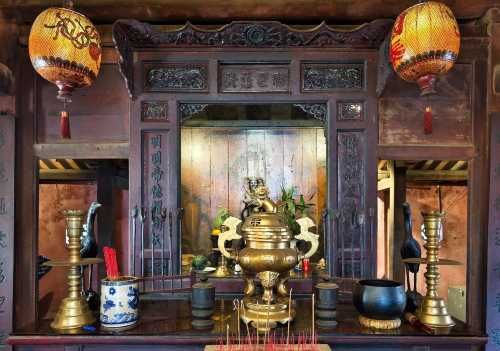Did you know the iconic landmark on Vietnam’s 20,000 dong note is the Japanese Covered Bridge in Hoi An? 🏯✨ Built in the 17th century by Japanese merchants, it symbolizes the blend of Japanese, Chinese, and Vietnamese cultures. Visiting this bridge feels like stepping into the note itself — full of history, charm, and beauty. Don’t miss this must-see spot when exploring the lantern-lit streets of Hoi An! 🇻🇳💛 #HoiAn #Vietnam #Travel
jamesmtlim
Hoi An Ancient Town, Vietnam | Nhà cổ Tấn Ký: A 200-Year-Old House Where Chinese, Vietnamese, and Japanese Cultures Fusion Deep within the old streets of Hoi An Ancient Town lies a well-preserved old house, the Nhà cổ Tấn Ký. Built in the late 18th century, it boasts over 200 years of history and is one of the most representative traditional houses in the area. Once the home of a wealthy merchant, it epitomizes the diverse cultural landscape of Hoi An. The house is designed in a long, narrow structure, with shops in front and residences in the back, convenient for merchants and travelers. The courtyard and halls are constructed of wood and brick. The roof features Chinese-style eaves, while the walls retain the traditional Vietnamese simplicity, with Japanese-style beams visible. The overall design is both practical and elegant, reflecting the prosperity and diversity of Hoi An as an international trading port.
諸文武
Hoi An Ancient Town, Vietnam | Chùa Cầu Bridge: A Century-Old Covered Bridge Where Japanese and Vietnamese Cultures Meet, Quietly Preserving the Ancient City's Prosperity and Transcendence Among the many landmarks of Hoi An Ancient Town, the Chùa Cầu Bridge (Chùa Cầu) stands out. Built in the early 17th century by Japanese immigrants, this wooden bridge is also known as the "Japanese Bridge." It serves not only as a bridge for transportation but also as a symbol of cultural exchange. The bridge is constructed of solid wood and bluestone, with a tiled roof and intricate carvings along its sides. Inside, a porch enshrines the Bac Tai, the God of War, praying for good weather and safe journeys. Walking across the bridge, one feels the weight of history, as if every plank bears the footprints and stories of merchants and travelers. At dusk, lanterns are lit, and the Chùa Cầu Bridge's silhouette is reflected on the river, like a scene frozen in time. Quietly spanning the stream of the ancient town, it has witnessed centuries of prosperity and transformation in Hoi An.
諸文武
Hoi An Ancient Town, Vietnam | Evening Stroll: Encounter the Gentleness of the Ancient City in the Lights of the Alleys As dusk falls, stepping into Hoi An Ancient Town, the atmosphere begins to transform. The bustle of the day gradually fades, and the streets are bathed in golden and orange hues by the setting sun. The ancient walls and mottled wooden windows appear particularly charming in this soft light and shadow. The ancient town is perfect for a stroll at this time. Pedestrians slow their pace, chatting outside lantern-draped shops or strolling quietly along the Thu Bon River. The light of the newly lit lanterns reflects on the river, and a gentle breeze caresses your face, making even time seem to slow down. A stroll in Hoi An is more than just a part of travel; it's a kind of solace. You can capture the street lights with your eyes and feel the centuries-old atmosphere of this ancient city with your heart.
諸文武
Hoi An Ancient Town, Vietnam | Leisurely Moments Before Dusk: Sit Down and Slow Down with the Ancient Town Before night falls, Hoi An Ancient Town offers a distinctly different atmosphere from the bustling atmosphere after the lanterns are lit. The yellow walls reflect the setting sun, and the streets are devoid of the daytime bustle, replaced by a gentle, leisurely atmosphere. Music wafts from the doorways of small shops, and groups of people gather in cafes, chatting or quietly reading. A gentle breeze drifts along the riverbank, and even though the lanterns haven't yet been fully lit, the gentleness of approaching night is already faintly revealed. In this atmosphere, it's tempting to sit down, order a cup of coffee or a refreshing iced coconut drink, and simply enjoy a moment of rest. Everything before you is unplanned, allowing travelers to slow down and experience the authentic atmosphere of the ancient town.
諸文武
Hoi An Ancient Town, Da Nang, Vietnam | The Chùa Cầu Bridge: A Quiet Japanese-Style Bridge, a Witness to Transcendence and Time Among the many historic buildings in Hoi An Ancient Town, the Chùa Cầu (Japanese Covered Bridge) is undoubtedly one of the most iconic landmarks. Built in the 17th century by Japanese merchants, it connects neighborhoods on both sides of the river. For centuries, it has served not only as a vital transportation hub but also as a witness to cultural exchange and historical change. Mostly constructed of wood, the Chùa Cầu Bridge features a tiled roof and intricate carvings. Stone statues of monkeys and dogs guard each end, symbolizing the passage of time. A small shrine dedicated to the North Pole Xuantian God stands in the center of the bridge, symbolizing the protection of the bridge and passersby. During the day, visitors flock to the bridge, and its rustic charm contrasts with the yellow walls and green windows on both sides, imbued with a sense of history. At night, illuminated by lights, the Chùa Cầu Bridge's reflection in the Thu Bon River creates an even more tranquil and romantic scene.
諸文武
Danang, Vietnam | The Chinese Assembly Hall in Hoi An Ancient Town: Chinese Memories and Trans-Sea Faith Amid Red Tiles and Blue Bricks Among the many guild halls in Hoi An Ancient Town, the Cantonese Assembly Hall (Cantonese Assembly Hall) stands as a unique center for Chinese worship and gathering. Built by immigrants from Guangdong and South China, its history dates back to the mid-17th century and carries the story of Chinese people's southern migration. The hall's exterior is adorned with vibrant red and green, its roof adorned with intricate ceramic dragon and phoenix carvings, and majestic stone lions guard the entrance. Entering the hall, the main hall enshrines Guandi, a deity symbolizing loyalty and protection, and a source of spiritual support for Chinese living abroad. Deities such as Guanyin and the God of Wealth can also be seen within the hall, where incense burns abundantly, expressing prayers for peace, success, and prosperity. Beyond its religious functions, the Chinese Assembly Hall was once an important gathering place for the Chinese community. Ancient wood carvings, stone carvings and plaques not only demonstrate the beauty of craftsmanship, but also record how overseas Chinese took root in Hoi An, the ancient trading city.
諸文武
Colorful Lanterns, Ancient Walls—Hoi An’s Timeless Charm 🎏🌅 Hoi An’s Old Town comes alive as dusk falls—lanterns glowing, riverboats drifting, and centuries-old streets inviting you to wander. Start your evening at Duc An House (129 Trần Phú, 8:00–21:00), savoring its vintage architecture and bookish vibe (perfect for quiet photos of wooden carvings and sunlight streaming through antique windows). Next, stroll towards Quan Cong Temple (24 Trần Phú) for bold reds and statement dragons—make sure to snap the ornately decorated altar for that “iconic Hoi An” shot. When the sky shifts to purple and gold, continue to the riverside for a magical night boat ride among floating lanterns. This is pure Hoi An magic! For a sunset memory, perch on the edge of the river—capture golden reflections and multi-colored lights flickering on the water (the ultimate insta-worthy moment!). Then dive into Hội An Night Market (Nguyễn Hoàng, 18:00–22:00) for street eats, vibrant lanterns, and the best souvenir shopping. Try crispy Banh Mi or fresh spring rolls as you explore. Don’t miss Bài Chòi Hội An (Old Town, 19:00–21:00) where live folk singing adds extra sparkle to your stroll. If curious about local spirituality, pass by Hội Thánh Tin Lành Việt Nam (114 Đ. Phan Chu Trinh) for quiet photo ops or a reflective moment. Tips: First-time visitors—going after sunset adds extra magic! Wear comfy shoes for cobblestone lanes, keep cash for market nibbles, and bring a light jacket (evenings can be breezy by the river). Watch your step boarding those lantern boats. #HoiAn #LanternNight #VietnamCulture #SunsetVibes #TravelAsia
CHONG SOON FAI
Popular Trip Moments
🇻🇳[Hoi An] Sunset, a glass of the sea's gift — Afterglow at Ubebe in Hoi An | Hoi An Magic Day✨Chasing colors | 🌿 รีวิว Legacy Hoi An Resort – สวรรค์แห่งความสงบใ | 🇻🇳[Hoi An] The taste of learning found on the main street of Hoi An, NOODLE House by STREETS | Day 3 of my Da Nang trip | Hoi An a perfect cultural heritage | 🇻🇳[Hoi An] Leisure in an open space, a place for Vietnamese people to relax, KAYO COFFEE HOUSE | 🇻🇳[Hoi An] A place where refined taste and leisure linger, Thúng Hội An Restaurant | Heart of Central Vietnam: DaNang and HoiAn 🏮 | 🏮 Hoi An Old Town: A Walk Through Time | 🛶 Hoi An's emotional experience, basket boat | Highly recommend Cozy An Boutique Hotel | Hoi An Heritage Walk🚶 Discovering Japan’s Legacy in Hoi An | Sunny Hoi An Vibes☀️ | Uncle Huan, a Hoi An cafe with a great view of Ba Mu Temple | Faifo coffee, a popular cafe in Hoi An Old Town💛 | Giving away a travel plan for Da Nang and Hoi An for under ten thousand! | Vietnam's UNESCO World Heritage Site, Hoi An Ancient Town | Recommended 4-day trip to Da Nang | BEST value for money vacation in Asia | ☕️ Hoi An Cafe Tour | Hoi An Rooftop Cafe & Bistro | Hoi An bubble tea restaurant | Hoi An's Cozy Cafe Vibes | A Travelogue of Hanoi, Vietnam: Encountering the Symphony of Life on the Thirty-Six Streets | Fall in love with Hoi An 🇻🇳 | Enjoying Hoi An | One must-try experience in Hoi An 🪔
Recommended Attractions at Popular Destinations
Popular Attractions in Bangkok | Popular Attractions in Kuala Lumpur | Popular Attractions in Dubai | Popular Attractions in Chefchaouene | Popular Attractions in Kyoto | Popular Attractions in Los Angeles | Popular Attractions in Bali | Popular Attractions in Shanghai | Popular Attractions in Iguazu National Park(Argentina) | Popular Attractions in New York | Popular Attractions in Paris | Popular Attractions in Walt Disney World Resort | Popular Attractions in Melbourne | Popular Attractions in London | Popular Attractions in Singapore | Popular Attractions in Beijing | Popular Attractions in Las Vegas | Popular Attractions in Rome | Popular Attractions in Zanzibar Island | Popular Attractions in Sydney | Popular Attractions in West Lake | Popular Attractions in Osaka | Popular Attractions in Tokyo | Popular Attractions in Phuket | Popular Attractions in Barcelona | Popular Attractions in Madrid | Popular Attractions in Chengdu | Popular Attractions in Florence | Popular Attractions in Istanbul | Popular Attractions in Jungfrau Region
Popular Attractions
Daming Temple | Labor Park | He Garden | Gumulan Yard Shita | Guanyin Mountain | Wenfeng Tower | Crane Temple | The Shi Kefa Museum | Dalianwan Fort | Yangzhou Shuangbo Museum | Yechun Garden | Hengshan Mountain College | Zhanqiao Park | Tsing Ma Bridge | Repulse Bay | East Lake | Yangshan Stone Buddha | Hou Mountain | Alwal National Park | Woodstock Baseball Field | Vessy Sports Center | Boulodrome | Spa Elysium | Landschaftspark Wiesengrund | Rocher de Vitrolles | Imam Muhammad al-Ghazali Mosquée | Atha Massage Clinic | Plaza del Ayuntamiento | House of the Xue Family | Cuihua Mountain·Qinling Zhongnanshan Unesco Global Geopark
Popular Restaurants in Hoi An
Madam Khanh - The Banh Mi Queen | White Rose Restaurant | Com Linh - Vietnamese Restaurant | Miss Ly Cafe | Cong Caphe (Hoi An) | Silent Garden Restaurant | Minh Hien Vegetarian Restaurant | Faifo Coffee | The Cargo Club | Viettown- Hoi An | An Bang Beach Village Restaurant | Golden Lotus | Nu Eatery | Jack's Cat Cafe | The Temple Restaurant & Lounge | TIA Coffee & Restaurant | Restaurant HAVANA | Morning Glory Signature | Havana Bar & Restaurant | Vy’s Market Restaurant & Cooking School | Otta Cuisine | Nostalife | Trung Bac Restaurant | Lantern Town restaurant | Vinh Hung Restaurant | Vegan Zone Hoi An | Rice Drum | Cay Me | AN GIA cottage | Hoi An Burgers Plus
Popular Ranked Lists
Top 20 Premium Hotels in Shangri-La | Top 10 Premium Hotels in Guangyuan | Top 10 Trending Attractions in Dubai | Top 20 Premium Hotels in Jinhua | Top 20 Trending Attractions in Wuhan | Top 50 Must-Visit Restaurants in Seattle | Top 10 Luxury Hotels in Chongqing | Top 10 Premium Hotels in Lhasa | Popular Trending Attractions in London | Top 10 Trending Attractions in Changsha | Top 50 Must-Visit Restaurants in Langkawi | Top 50 Must-Visit Restaurants in Dubai | Top 20 Premium Hotels in Nanchang | Top 20 Luxury Hotels in Beijing | Top 10 Must-Visit Restaurants in Bad Ischl | Top 20 Premium Hotels in Changchun | Popular Luxury Hotels in Xi'an | Top 50 Must-Visit Restaurants in Auckland | Top 10 Trending Attractions in Tokyo | Top 20 Trending Attractions in Suzhou | Top 10 Luxury Hotels in Chengdu | Top 10 Local Restaurants in Lushan Global Geopark | Popular Premium Hotels in Panjin | Top 50 Must-Visit Restaurants in Sanya | Top 50 Must-Visit Restaurants in Beijing | Top 20 Premium Hotels in Quanzhou | Top 50 Must-Visit Restaurants in Changsha | Top 10 Trending Attractions in Xiamen | Top 50 Must-Visit Restaurants in San Francisco | Top 20 Premium Hotels in Dali Prefecture
About
Payment methods
Our partners
Copyright © 2025 Trip.com Travel Singapore Pte. Ltd. All rights reserved
Site Operator: Trip.com Travel Singapore Pte. Ltd.
Site Operator: Trip.com Travel Singapore Pte. Ltd.


































